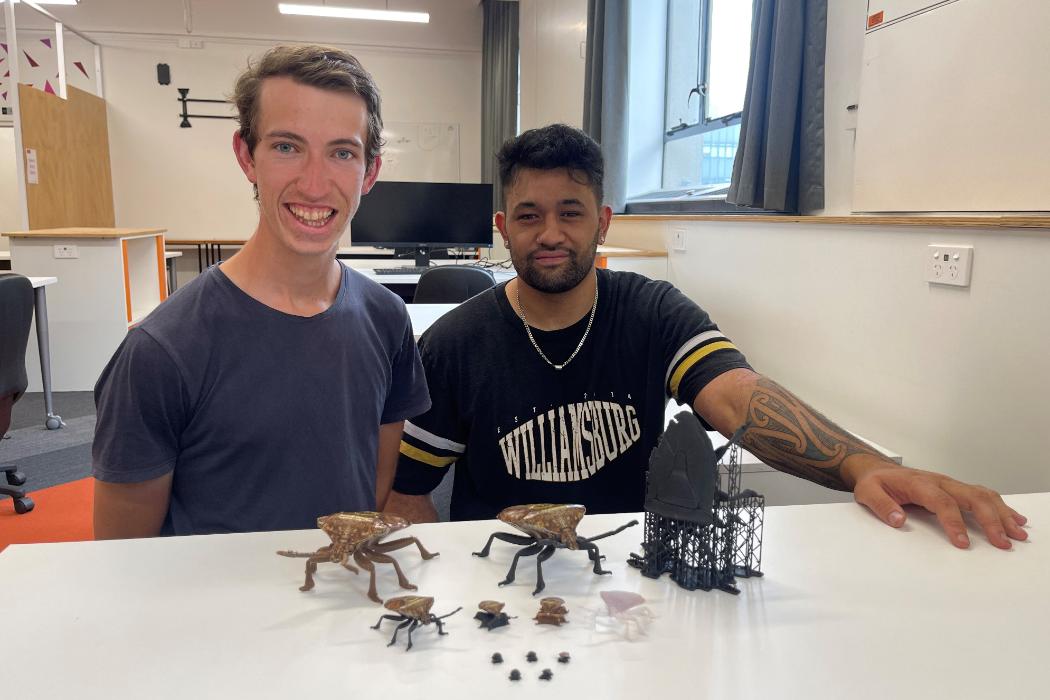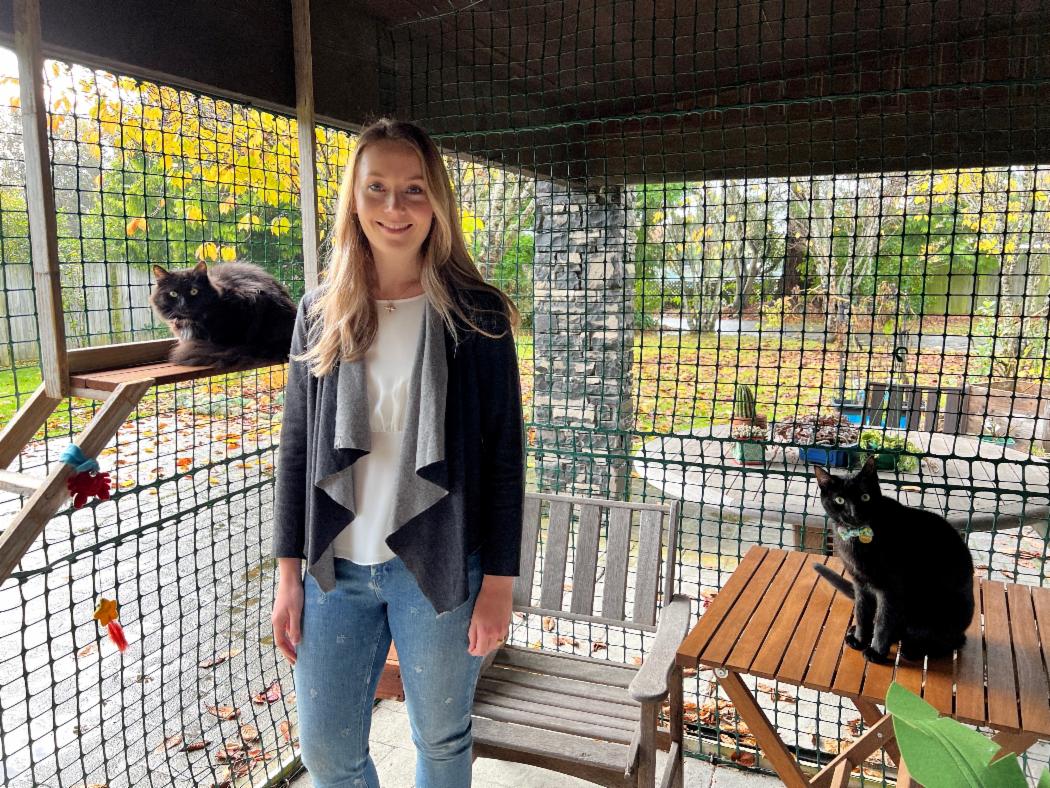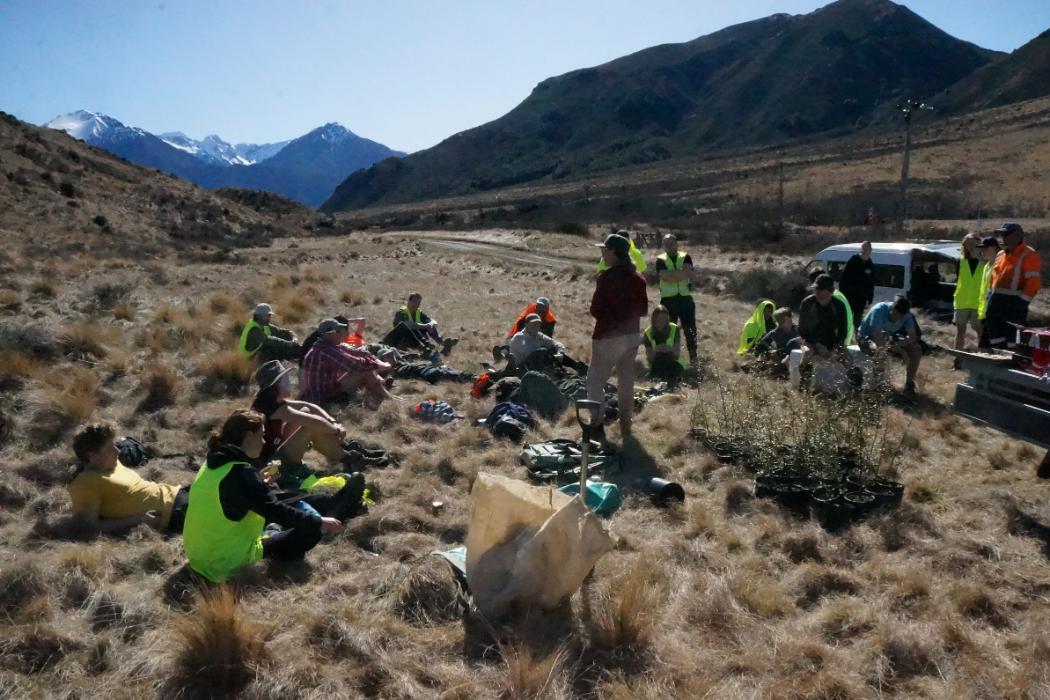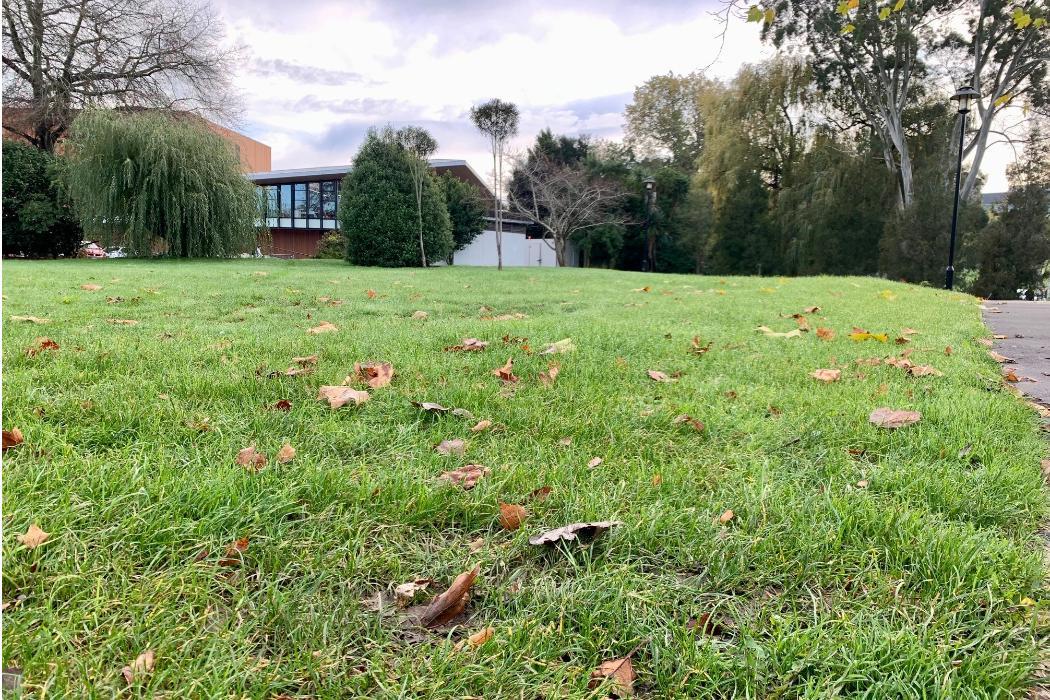Rare sightings following campus biodiversity work
Recent sightings of a native falcon at UC suggests strategies to attract native birds back to campus are proving effective. The sightings, confirmed by Professor Jim Briskie and Dr Sara Kross, are believed to be the first time a native falcon has visited the Ilam campus. The sightings complement evidence that kingfisher and black-backed gull are nesting on campus for the first time. Native bird counts, coordinated by Professor Briskie, also found fantail and grey warbler numbers appear to have increased, while shining cuckoo have been heard singing. “It is wonderful to see these treasured species visiting and inhabiting the campus again. It is testament to a comprehensive approach that will continue to improve the populations of native insects, birds, fishes and reptiles on campus and ensure the University is a valuable part of the north-western corridor of Christchurch,” says UC’s Professor Jan Evans-Freeman, Pro-Vice-Chancellor Sustainability.
Rewilding to create luxury lodgings for campus critters
A prime piece of campus lawn is to be reverted to wildflowers to provide habitats and food sources for insects. Preparations are underway to transform a 1500m2 section of lawn between UC’s health centre and student association building into a trial biodiversity meadow that is expected to create greater numbers and diversity of insect life, and in turn attract native birds and reptiles. Wildflowers will be sown, which, although not native flora, will nonetheless support native biodiversity. The project is part of our Biodiversity Plan, which aims to increase diversity of native plants, insects and birds on campus and improve stream life, providing a vital link in the ecological corridor of the city’s northwest. The project will provide environmental science students with opportunities for learning activities and may be utilised for wellbeing by students and staff, as an attractive space humming with plant and insect life. UC’s grounds team have already employed habitat borders around trees and other selected no-mow or low-mow zones to promote insect biodiversity.
Student biologists spot hundreds of species
Biology students and staff scoured UC’s Cass Mountain Research Station over a weekend, identifying hundreds of lifeforms, from lichens and fungi to slime mould and insects, including species new to the region. Field work has been conducted at Cass Station since 1914, hosting hundreds of researchers, students, and visitors over the last century. However, recent biologists used modern tools to help them record hundreds of species sightings; their mobile phones and the iNaturalist app, an open-access social network that encourages anyone – from citizen scientists to expert biologists – to record observations of species, engage with a community and help to map biodiversity around the world.
Ground-breaking study uses pine slash to improve soil
Student Mingyuan (Kathy) Liu is investigating the use of pine waste mixed with urea fertiliser on silt-covered soils from Canterbury and Gisborne. Liu says with flooding becoming increasingly common, and pine slash (a waste product from commercial forestry) causing issues, and the study indicates there’s a real opportunity to use one challenging waste problem - pine slash - to fix another - silt-covered soils. “We’ve looked at blending pine waste into finer sawdust particles and mixing them with the soil and some fertiliser to make the soil more porous - better for water drainage and for plants to grow,” Liu says. The results in a campus greenhouse show a large increase in soil fertility, and she says field testing is now required. Liu’s Supervisor Professor Brett Robinson says preliminary results are exciting. “Pine slash is a current issue facing New Zealand and the rest of the world. To date, we know of no other reports detailing the rehabilitation of flood-deposited sediment using pine waste. We hope to take it to the next stage of field testing soon,” says Professor Robinson.
PhD student wins International Biosecurity Award
Delegates of the International Conference on Biological Invasions gathered in Christchurch to discuss effective responses to global challenges and threats that invasive alien species present to biodiversity, ecological systems, and food production and security in terrestrial, freshwater and marine ecosystems. UC PhD student Sarah Sale gave an award-winning presentation at the Conference. Following her talk about the impacts of myrtle rust on different species, the Biochemistry doctoral candidate won the award for Outstanding Student Oral Presentation. “Myrtle rust causes bright yellow pustules and infects over 500 different species including mānuka, pōhutukawa, rātā and feijoa. We’re getting closer to artificial infection in the laboratory so that we can trial methods for its control”, said Sale. Director of the UC Biosecurity Innovations grant, Professor Steve Pawson said, “It’s important that our students are aware of the global issues biosecurity creates.”
Our new Biodiversity Plan
UC is committed to improving biodiversity on campus. Our new Biodiversity Plan (2022-2025) sets out ambitious targets and actions, including improving plant diversity with a diverse range of new plantings; improving bird populations by focusing on establishing bird-friendly plants and predator control; improving stream life by focusing on stormwater treatment to benefit invertebrates and fish; improving cryptic biodiversity, with microbes, fungi and invertebrates benefiting from unmanaged areas of native plantings; improving conditions for Taonga species, and enhancing Ki uta ki tai (connections between mountains and sea).
Pretty but invasive
An invasive weed threatening to swamp our waterways is the focus of UC Master’s student Aaron Millar. Colloquially known as monkeyflower, the plant is particularly prominent in Canterbury and Otago, although found throughout the country. Millar says monkeyflower grows extremely thickly and can complete fill small waterways. For his Master of Science in Biology, Millar is looking at why monkeyflower is so successful in such a range of environments. Monkeyflower, more formally known as Erythranthe guttata, was introduced to Aotearoa New Zealand by pakeha settlers in the colonial period. Originally from North America, it was kept as a garden plant in Britain, and they liked the look of it enough to bring it here. Scotland is also fighting its invasive impact.
20-year quest to restore rare African forest
UC’s Associate Professor Hazel Chapman is the powerhouse behind the Nigerian Montane Forest Project, which she established at Ngel Nyaki 20 years ago. On a remote Nigerian plateau, in one of Africa’s rarest ecosystems, sits a model for biodiversity conservation that has created local jobs, accommodated PhD students, produced valuable research, discovered new species, and given hope to the community for a better future for their children. It’s the community involvement that Associate Professor Chapman is most proud of: “the project has 36 well-trained, full-time employees, all on good salaries, the village has a nursery school, the forest is growing back, and hunting is considerably reduced”.
3D printed bug raising awareness
Two UC students in our School of Product Design spent their summer developing and 3D printing a larger than life-size model of the brown marmorated stink bug to help raise awareness of the potential for a costly invasion of the pest in the country. The project was part of the Better Border Biosecurity (B3) summer studentship programme, a collaboration involving New Zealand Crown Research Institutes, universities, government, industry, Iwi and other stakeholders, that aims to strengthen the country’s biosecurity system and protect valued native flora from invasive pests.
Trees, worms, and learning
Holes were dug and worms were wondered over as Ilam Primary School children planted native trees on our Ilam campus next to their school. UC groundskeepers Darryl Cone and Richard O’Dowd, with landscape ecologist Adjunct Professor Colin Meurk, advised and assisted the planting efforts. UC Envirosoc students, an environmentally focused student club, and the Student Volunteer Army helped to dig holes and support the younger landscapers. The planting connects to previous planting on Ilam campus as part of UC’s aim to increase natural habitats for native birds, lizards, and insects on our grounds.
Investigating the mathematics of extinction
Two UC mathematicians have been granted a Marsden Fund to investigate mathematical models for extinction events in the tree of life. Using a mathematical and algorithmic framework, Distinguished Professor Mike Steel and Professor Charles Semple hope to address some fundamental questions in biodiversity theory and conservation. “Unfortunately, human impacts on the natural world are precipitating a sixth mass extinction,” says Professor Steel. “We intend to develop and apply new mathematical techniques and models to investigate the precise relationships between the different measures of biodiversity that are based on evolutionary trees and explore the extent to which extinction of species is linked to the loss of feature diversity.” Additionally, the research team aims to develop and apply more complex models of multiple species loss based on ‘extinction cascades’, investigating their impact on feature diversity loss.
Forestry Education for Goal 15
UC offers a range of course options to equip the next generation in sustainably managing forests in Aotearoa New Zealand. Environmental Forestry provides students with an overview of the broader environmental and cultural issues associates with plantation forestry. Forests are particularly important as they provide many key ecosystem services that are not necessarily provided by other comparable land uses such as farming. The course focuses on a range of the ecosystem services provided by plantation forestry including biodiversity conservation, soil and water conservation, and cultural services. As the title suggests, Forest Management provides students with an understanding of forest management decision-making. Forestry managers and owners make significant strategic and operational decisions regularly, such as what volume of wood to harvest each year, whether land should be replanted after harvesting, and silvicultural regimes.
Native birds on campus more than tripled
Since 2016, we have been monitoring birdlife on our Ilam Campus. Monitoring gives us a snapshot of numbers of species, and numbers of birds, which helps us to enhance our biodiversity efforts, particularly of indigenous species. While there have been variations in counts over the years, which is to be expected from a count of this type, during the summer of 2020/2021 an extensive analysis found the number of native birds, such as bellbird, fantail, swallow, silvereye, have more than tripled, and 5-7 more native species have since colonised on campus.
Using audio to lure predators
Building new science capability is critical for achieving all of New Zealand’s environmental goals. Our country’s brightest young minds are setting out to revolutionise pest management, in helping efforts to eradicate possums, stoats and rats by 2050. Ben McEwen is a Computer Science PhD candidate, and recently graduated with a BE(Hons) with First Class Honours specialising in Mechatronics Engineering.
Ben aims to investigate and develop new predator luring technology and develop a system that uses state-of-the-art visual and audio technology to identify predator species in real time, allowing populations to be estimated, and audible lures to be automatically selected, making trapping more effective. This system has the potential to significantly improve predator interaction rates with traps.
Understanding Biodiversity loss
Global Change Biology, a course offered by our School of Biological Sciences course, addresses selected major issues concerning the role of biological processes in the Earth System and the impact on these of human activities (global change). The course covers a range of broad topics where students can gain understanding of how actions result in ecosystem change, and then relate this to social and economic trade-offs that underpin environmental decision-making. For example, discussion on issues include the significance of biodiversity loss on ecosystem processes and strategies to mitigate climate change, and the impacts of past and future climate change on biota.
Freshwater Biodiversity Box for Junior Students
It’s vital the next generation of researchers understand our natural environment to maintain its resilience and productivity for the continued well-being of future New Zealanders. The Freshwater Biodiversity Box is a dedicated set of freshwater sampling gear and activities, available to Canterbury school children. Junior learners can connect with and support conservation within the Canterbury region by exploring freshwater biodiversity and learning about ecosystem health in waterways. The box has tools to sample freshwater invertebrates, including activities based on healthy freshwater habitats and food webs. The idea was developed by the Canterbury Waterway Rehabilitation Experiment (CAREX) at UC’s School of Biological Sciences. CAREX focus on solutions that can be applied across waterways in Canterbury, Aotearoa and beyond, and address aquatic weed, sediment and nutrient management issues in lowland Canterbury to improve waterway health.
Students take on predators
Students are launching a predator control operation aimed at reducing the number of predators on campus. Early studies have shown that rats, stoats and possums are all present on campus. The trapping is hoped to reduce predator numbers and therefore reduce predation on native fauna. Envirosoc students have been involved in monitoring and will commence trapping this winter.
The different predators are targeted with different traps that will be laid initially along the Avon Haere Roa river and also through Ilam Gardens. Student volunteers will be given a certain number of traps to look after and the tools to do the job. Full support is given to inexperienced trappers.
Biodiversity Projects Coordinator Emily Arthur said the monitoring and trapping was a great way to help students gain practical skills and understanding of predator control and monitoring operations.
Students can get in touch Envirosoc to learn how to get involved. Staff to contact the Sustainability Office.
Student Launches Predator Free Riccarton
Phd student Jade Humphrey is passionate about protecting bird life. So much so that she has set up Predator Free Riccarton; a programme where members of the community are supported to trap predators in their back yards. Their aim is to get one trap in every five backyards in Riccarton.
The Riccarton community includes green spaces, such as Riccarton Bush and corridors bordering tributaries of the Avon River, which could form sanctuaries for our native species to thrive, but isn't possible with current pest populations.
The project is supported by the Predator Free NZ Backyard Communities Fund, which has given them the opportunity to heavily subsidise traps for community members. Victor traps (including trap boxes) are available for the discounted price of $15, which goes towards covering material costs.
The group help novice trappers by providing trapping tips, health & safety, maintenance and recording catches using Trap.NZ.
They are supporting the trapping efforts with clean ups, removal of weed/invasive species, native tree plantings, soft plastic recycling and cat owner education.
Follow their journey on Instagram or to get in touch email predatorfreericcarton@gmail.com.
Forestry Achievers Recognised
Professor Bruce Manley and UC alum Adrian Loo were named as two of 2020’s Aotearoa forestry high achievers. The New Zealand Institute of Forestry awarded Professor Manley the highest honour in NZ forestry – the Kirk Horn Award, which recognises outstanding contributions to the industry. Professor Manley is Head of UC’s School of Forestry. Adrian Loo received the Prince of Wales Award for Sustainable Forestry, which recognises young forest professionals who are highly engaged in the principles of sustainable forest management. Mr Loo works with landowners on diversification of land use through the addition of exotic and native forests.
Pest Control that Makes Scents
A long-term, novel solution to help New Zealand achieve its predator free ambitions is a step closer. Dr Michael Jackson and his team of postgraduate researchers from our School of Biological Sciences are working to create a multi-species lure that can be used to catch different types of introduced predators. At the heart of this new research is identification of the chemical compounds needed to attract multiple species. The success of the project is multi-layered, as Dr Jackson views the success of students’ research on par with his own research outcomes. “It would be quite cool, at the end of this project, to see our Masters’ students graduate and maybe go on to their PhDs or into business, knowing they’ve been successful with their research,” he says.
Robotic Farming Looking After the Land
Robots could soon be helping farmers manage arable land in a cleaner, greener way. UC students won a Callaghan Innovation prize in 2020 for their robotic farming system, which would support planting multiple species rather than one type of crop over a large area. The students say their “approach was to completely rethink arable crop production to enable a more regenerative type of agriculture. We’re hoping to mitigate the impacts of industrial agriculture on climate change by reducing carbon loss that happens during tilling of topsoil. We want to help farmers be good custodians for the soil and also run a profitable farm.”
Native Tree Restoration
Our School of Forestry is leading the expansion of a Restoration Ambassadors programme, with Te Uru Rākau (Forestry New Zealand) providing funding from the One Billion Trees Fund to run the programme. It will see two restoration ambassadors cover more areas of Aotearoa, providing expert advice to farmers and landowners on how to restore native planting and manage areas of biodiversity. UC’s Professor David Norton, who has been a driving force behind the ambassador project, says it will help meet demand from South Island farmers. “There’s huge interest from farmers down here needing advice on how to establish native forests on their land. Having two people in the role will mean more free and independent advice can be provided to farmers, iwi and others in rural Aotearoa on how to carry out good quality, planned ecological restoration.
Active forest regeneration In Nigerian montane forest
UC is a major partner in the Nigerian Montane Forest Project. Our broad-based approach to forest restoration contributes to Nigeria’s biodiversity strategy.
During the rainy season of 2020, 5,680 seedlings of forest tree species were planted into 20,000 m2 of grassland within the reserve, adding to ten years of previous plantings to help regenerate Ngel Nyaki forest. In addition to this effort, 9,162 seedlings have been raised in the plant nursery this year to transplant out in the 2021 rainy season. We now have two nurseries at Ngel Nyaki and collecting seeds and growing seedlings is a full time job for two field assistants.
Encouraging greater biodiversity and conservation on farmland
Professor David Norton, of the School of Forestry, runs workshops for farmers on increasing native biodiversity on their farms, and sharing best practice and key principles in sustainable land management.










